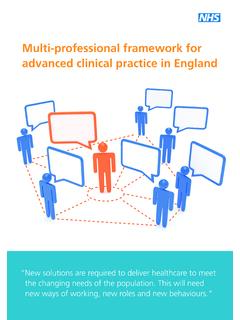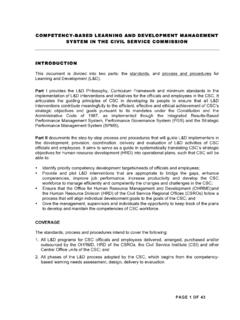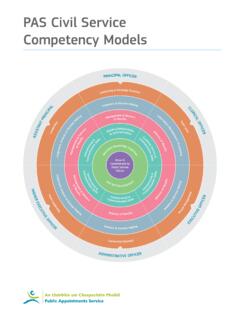Transcription of Care Navigation: A Competency Framework
1 Care Navigation: A Competency Framework Health Education England 2016I must go down to the seas again, to the lonely sea and the sky,And all I ask is a tall ship and a star to steer her byJohn Masefield (from Sea Fever, Salt-Water Ballads, 1902)3 Contents1. Introduction 42. Care navigation and why it is important 63. Who provides care navigation? 84. What is the evidence for care navigation? 105. What is the purpose of a Competency Framework ? 126. How the Framework was developed 137. Framework overview 188. Navigating the Competency Framework 199. Education and training 3210. Building education and career pathways 3411.
2 Case studies 36 Appendices 42 Appendix 1: Key principles which underpin person-centered care and support 43 Appendix 2: Principles of patient navigation. 44 Appendix 3: Example job descriptions for each Framework level 45 References 53 Further reading 55 Acknowledgements 57 Health Education England 201641. The word navigator derives from Latin navis - ship - and agere - drive - meaning a person who steers a ship . Charting stormy uncertain seas requires good navigation with purpose and direction. Similarly, most people at some point in their life may benefit from navigation through encounters with different health services, agencies and professionals, across an often confusing seascape of health, social and community care.
3 And it s not just an issue for service users, there is broad consensus from healthcare professionals that such systems can be complex and difficult to Effective navigation is a key element of delivering coordinated, person-centered care and support (see Appendix 1: Key principles which underpin person-centered care and support). Care navigators can play a crucial role in helping people to get the right support, at the right time to help manage a wide range of needs. This may include support with long term conditions, help with finances and signposting to a range of statutory and voluntary sector The purpose of this document is to describe a core, common set of competencies for care navigation.
4 These core competencies are brought together in a tiered Competency Framework , recognising three successive levels; essential, enhanced and expert. This will help provide a coherent benchmark or set of standards for care navigation, to help ensure relevant staff receive the necessary education, training and support to work effectively. This Framework may be used by employers, education providers and individuals to inform education and training needs. It will also help lay the foundations for a career pathway Framework for non-clinical staff, within primary and secondary care sectors. This is important to secure a sustainable current and future workforce, offering opportunities for Navigator roles, job titles and day-to-day tasks vary depending on local context, including organisation function, peoples existing skills and local population need.
5 For example care coordinators and care navigators may work in hospitals, focusing on discharging people safely from hospital to home, or as part of a general practice in a multidisciplinary team. There is no one size fits all navigation service, with variations throughout the UK and internationally. Whilst flexibility and variation to meet local need is appropriate and expected in job roles, this Framework seeks to articulate some common generic threads , to promote a consistent approach to training and A key concept in this work is an attempt to move away from the labels of job roles or fixed titles . Roles developed in isolation are difficult to sustain, and lack of national recognised Competency Framework can limit people to use skills elsewhere or build their careers.
6 By instead, keeping focus on the core tasks, purpose and core competencies of care navigation , this can help promote standardisation and recognition of people providing care navigation, and open up opportunities for people from many backgrounds and in a plethora of The competencies are not intended to be all encompassing and comprehensive; depending on some areas of work and population served, there may need to be additional extra or bolt on modules/curricula and training for example working 5with a condition-specific group of people stroke, learning disabilities. The Framework as a whole is intended to be a guide and will undoubtedly evolve over It has been recognised that through developing this Framework , there is a variety of different approaches to solving local problems around coordinating and signposting patients.
7 There are examples of different care navigation services and related navigator /signposting /coordinator roles around the UK. Roles developed in isolation are difficult to sustain. This work seeks not to replace but rather complement and support these efforts. There will be ongoing need for commitment to share, coordinate and work together across sectors and organisations to help support, provide education and training for people delivering care Care navigation and why it is There is widespread recognition that health and social care needs are changing. This includes an ageing population, with rising prevalence of people living with long term, complex conditions and needs.
8 There is a significant need to shift NHS service provision and professional working towards a paradigm of more sustainable, proactive and integrated health and social People with long term conditions often need to access different health services, with numerous assessments from multiple different professionals. This can be confusing and individuals and their families can encounter problems. Moving between different care settings can be an especially vulnerable time with the risk of slipping through the gaps . Often family or informal caregivers provide the only common thread to access and coordinate care from a long list of health and social care These issues are not new.
9 Care navigation is an emerging concept in the UK, intertwined with that of care coordination which represents the idea that simply having services and trained people in place are not enough. What then matters is how people (individuals, teams, services and systems) then work together in a joined up way so that people know when and how they can get access the right help, at the right time, in the right place. Indeed these themes of coordinated, person-centered care echo perspectives from patients2 and national and global policy ,4 In times of growing economic pressure within complex, fragmented health and social care systems, it is important to use our resources wisely; these include our workforce as well as the patients, families, carers and non-traditional services for example community and voluntary sectors (See Figure 1).
10 There is no universal definition of care navigation or a care navigator ; navigation at its heart is a coordination process and key ingredient to achieve integrated care provision to improve health and well-being. A person providing in care navigation is usually based in a multidisciplinary team, helps identify and signpost people to available services, acting as link ,7 The person who provides care navigation is therefore an important (though alone not sufficient) lynch-pin or enabler to achieving integrated care provision. Macredie and colleagues (2014) offer one definition of care navigation to Age UK defines care navigation to include the key components of.








![Midlands [1 of 2] - hee.nhs.uk](/cache/preview/6/c/1/4/2/e/2/7/thumb-6c142e2790d053a442bd8a3e81c79697.jpg)









